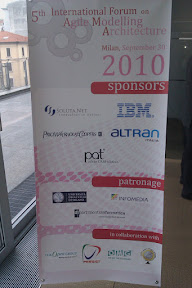I attended the 5th Model driven architecture and agile forum in Milano on September 30th.
Here are a few take away messages I got:
Richard Soley (Chairman and CEO of OMG):
- If IT departments of large enterprises don’t change, they are doomed to end up cleaning the floor and changing light bulbs. Entire IT division role need to be reinvented. Basically CIO role shall become_ to automate the business processes throughout the company, and even better: to optimize the processes, more than just automate (otherwise: risk of commoditization).
- Business Ecology Initiative: Green economy also means no redundant or inefficient processes. This and other communities of practice like: BPM/SOA, Green CIO, CyberSecurity, … are part of the current OMG strategy for sharing and exploiting experiences between companies.
- Models are going mainstream in the near future: “By 2013 graphical models in software will be used in more than 80% of new compositions” [Gartner]. And the purpose of standards is not to drive industry to a unique notation, but to make adaptation easier.
Stephen White (the main editor of BPMN):
BPMN is not able to bridge the gap between IT and business per se. However, it can combine with other languages, such as SoaML to solve the issue. Btw, this is in line with what we are doing now with WebRatio BPM: we integrate BPMN with WebML (and all its design dimensions) to address the gap and grant quick design and implementation.
Allen Brown (with The Open Group):
TOGAF and MDA integration is crucial for making the first work and the second actually implemented in the enterprise. I see TOGAF as a rather heavyweight methodology (à-la ITIL).
Stephen Mellor (one of the fathers of MDA):
You can be agile while developing with model driven methods, despite the agile critiques to MDA: i.e., that models don’t run, can’t be tested, are used just for documentation, require extra work and alignment. The criticism comes from a different understanding of the Model concept:
- Models as sketches: you draw them and then throw them away
- Models as blueprints: aim at directing and planning the implementation, under the assumption that construction is more costly than design
- Executable models: they are not just models, they are intended as part of implementation and for verification. They are built under the assumption that construction is less costly than design.
Now with executable UML models (xtUML) you can describe your actions and perform them on the models.
Thus MDA and Agile can merge, thanks to model compilers and alternative techniques. Why does it happen now and not 20 years ago?
Claus Torp Jensen (with IBM):
The question is: what are we modeling? software systems or business solutions?
We need strategic synergies betweeen Business strategies, SOA, BPM, and EA. Each of them in isolation can produce incremental results only..
Architectural models and requirements must be contextual, collaborative, consumable (i.e., understandable) and connected in nature for being useful and integrated in the business strategy of the enterprise. How to get there?
Semantics of the EA plan is not the same of the one in the BPM tool. You need to understand where is your work located: at business level (BPM), at information system level (business dependent IT), or at technology level (business independent IT). Each of them has his own “tribe” of people and will have its own tools and models.
But remember that copying is evil, even at the enterprise planning level. You shall not copy, but only define and preserve links between the levels and the models.
Morning panel
The biggest difficulty for companies adopting BPM+SOA+EA is:
- dealing with people habits and resilience to change (Soley)
- accepting standards (White)
- who to ask for guidance and training, and tools availability; communication between users, business lines, and other stakeholders (Brown)
- definitely people (Mellor)
- impatience of getting to the results (Jensen)
Software integrators will not disappear, but will need to change their activities basically to BPM integrators.
UML 3.0 will be out in 1.5 years or so. Now the working group is building the first draft.
If you don’t have a success measure for your BPM/SOA project, you are at risk of failure. Some KPIs must be defined and obviously must benchmark the processes before and after the project. BPMM (Business Process Maturity Model) can be used for that too.
About SOA, people tend to focus on reuse as the main advantage. But this is not the only aspect.
About standards: as anybody knows, they are not complete enough to grant interoperability of models or diagrams. You may choose to buy all the best of breed tools and make the integration yourself, or you can buy an integrated toolsuite and make the seller integrate it in your business.Standards are only the common denominator of all the producers, they cannot cover all the cases and scenarios.
Attendance.
Attendees to the event mainly included people from banking, software integration, (BPM and MDD) software producers, and consulting companies.



